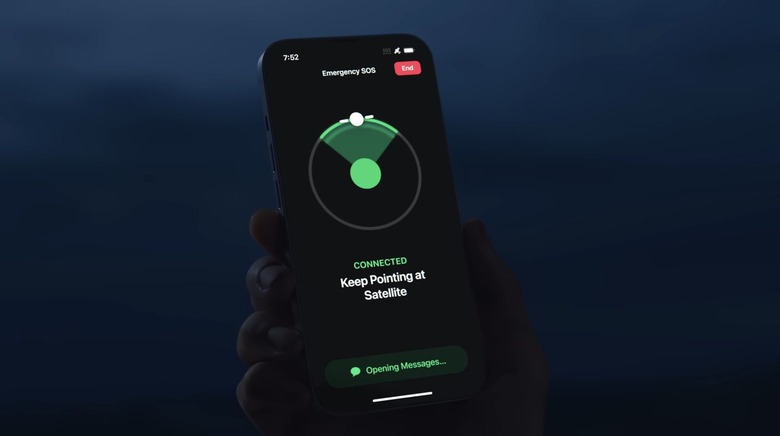A Closer Look At iOS 18's New Messages Via Satellite Feature
Apple introduced a variety of new features to its Messages app at WWDC this week. With iOS 18 – slated to arrive this coming September – iPhone users will finally be able to schedule texts and enjoy more expansive tapback options. On top of that, one of the more intriguing and exciting new Messages features is that iPhone users can leverage satellite coverage and send texts even without a cellular and Wi-Fi connection.
Now that WWDC is wrapping up, we've gleaned a few more details about how the feature works. Of course, the underlying technology is no different from Apple's Emergency SOS via satellite, which enables iPhone 14 users and above to contact emergency services when outside of range. For those unfamiliar, Emergency SOS via satellite is a free service Apple provides to new iPhone users for 2 years post-activation.
Earlier this week, CNET got a hands-on look at the new iOS 18 feature with Kurt Knight, Apple's Senior Director of World Wide Product Marketing. Knight relayed that all messages sent via satellite are end-to-end encrypted.
"It is just like using iMessage that you're used to, super easy," Knight said. "We have a custom protocol so that this is still end-to-end encrypted. We had to do extra work to make the [data] packets extra small because you need to be really efficient sending things up to space and back."
Apple added some limitations
As for keeping the data transmissions manageable, Apple instituted a few guardrails to ensure the service runs smoothly for everyone. For instance, iPhone users can rely on the feature to send text messages to anyone. Similarly, incoming texts from iPhone users will come in without a problem. However, non-iPhone users can't initiate an SMS conversation to a device linked up to a satellite unless they are a designated emergency contact or family member. Of course, SMS messages from non-iPhone users will go through if the conversation was previously started by the iPhone user.
Additionally, the new feature doesn't support the transmission of photos or video. It also doesn't work with group chats.
Also of note is that recipients will receive an alert indicating that an incoming message was sent via satellite. With respect to sending messages, when your iPhone finds itself disconnected from Wi-Fi and cellular networks, the phone will go into SOS mode, whereupon users can activate Messages via satellite either from the lock screen or directly from within the Messages app.
To ensure a smooth connection, Apple advises users to engage with the feature as follows:
- Be outside with a clear view of the sky and the horizon.
- Be aware that trees with light foliage might slow down the connection. Dense foliage, hills or mountains, canyons, and tall structures might block the connection.
- Hold your iPhone naturally in your hand. You don't need to raise your arm or hold your phone up, but don't put it in a pocket or backpack.
- If you need to turn left or right or move to avoid a blocked signal, your iPhone provides onscreen instructions.
- The satellite connection can be maintained even if your phone screen is locked.
- Satellite connectivity might not work in places above 62° latitude, such as northern parts of Alaska.
Expect the service to be a tad slow
As you might expect, communication via satellite will be slower than traditional connections. Apple advises that sent messages will take about 15 seconds to go through. If you happen to find yourself under trees or other subtle obstructions, messages might take over a minute to send.
A demo of the feature in use from iJustine is below:
